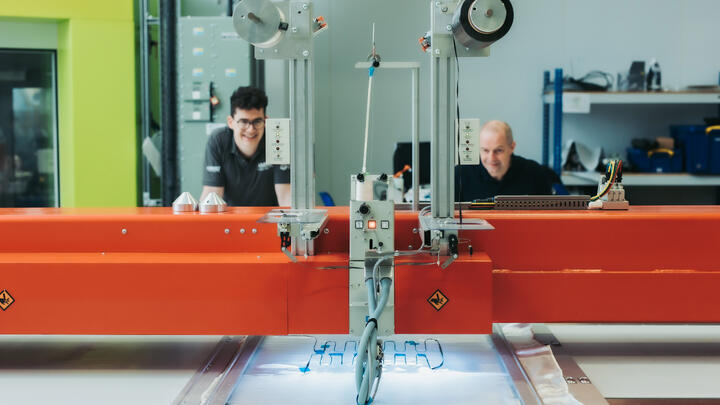Sustainable composites materials
How does it link to the digital thread concept?
The University of Sheffield Advanced Manufacturing Research Centre (AMRC) is demonstrating the foundations of a digital thread using an uncrewed aerial vehicle (UAV) concept – a complex manufacturing assembly.
Showcased alongside the UAV model, the single wing demonstrator made up of carbon fibre wing skin helps validate the UAV using a digital twin model without requiring a full-scale prototype of the assembly at this stage. The project takes a sustainability approach on the build to help the industry achieve net zero.
The challenge
To develop and de-risk the use of new sustainable materials for aerospace components that will increase life cycle and reduce cost.
Background
At MACH 2024, the University of Sheffield Advanced Manufacturing Research Centre (AMRC) showcased an uncrewed aerial vehicle (UAV) concept, alongside a single wing demonstrator made up of carbon fibre wing skin. The single wing demonstrator helps validate the UAV using a digital twin model without requiring a full-scale prototype of the assembly at this stage.
As an extension of the project, the composites team at the AMRC have manufactured two aircraft wing skin sections, using the same aluminium tooling as the single wing demonstrator. With a view to sustainability, the two wing skin sections are demonstrator components to show how bio-composites and smart, upcycled composites can be used as alternative materials for the UAV as well as for the wider manufacture of aerospace components.
Innovation
The AMRC has expertise in automated composites, dry fibre technologies, machining composites and structural health monitoring among other things. With this expertise, the AMRC has developed two wing skin demonstrators - using bio-composites and upcycled composites - that were manufactured on the DMU 340 G linear ultrasonic machine tool.
- Bio-composites demonstrator
The flax fibre reinforced bio-composite demonstrator has been manufactured using a traditional method of hand layup of pre-impregnated composite materials to demonstrate an example of sustainable fibre reinforcements.
- Upcycled composites demonstrator
Recycled carbon fibre veil has good stiffness but low strength due to the short discontinuous fibres. For this reason, the AMRC focused on improving the structural performance by selectively reinforcing with unidirectional tow using tailored fibre placement (TFP).
In addition, the AMRC integrated fibre optic sensors along the load paths with tow placement that can capture in-service data – providing smart sensing and structural health monitoring of the completed part.
Result
In the upcycled composites demonstrator, the use of TFP enables fibre paths to be steered to follow the principle load directions to maximise their effectiveness while adding the minimal extra material. This produces a resulting part that is still recyclable as only further carbon fibre is added, instead of any different material types being added.
Smart composites through integration of sensors during the manufacturing process also enable:
- data-driven decision-making in downstream processes
- cradle to grave health monitoring of components
- temperature measurement
Future impact
Composite moulding processes allow production of very complex parts in one go, reduce process times, help with lightweighting and ensure high-quality, high-volume production required by high-value sectors such as aerospace and automotive sectors.
- The use of recycled carbon fibres in the demonstrators de-risks the use of new sustainable materials – helping accelerate its adoption and utilisation for aerospace components to reduce the environmental impact of carbon fibre composite structures.
- The adoption of smart composites will help lengthen the life of composite components while reducing material and cost.


